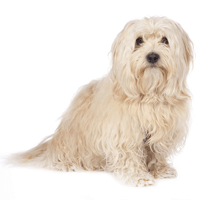
Major concerns: None
Occasionally seen: PRA, otitis externa, cataract
Avg Size of Female: Height: 8.5 – 11.5 inches, Weight: 7 – 13 pounds
Suggested tests: Knee, eye
Life span: 12 – 14 years
Minor concerns: Patellar luxation
Avg Size of Male: Height: 8.5 – 11.5 inches, Weight: 7 – 13 pounds
Brief History on Havanese Origin
This breed of dog was specifically bred for the upper class and it was always acquired as a gift, never sold. Due to it’s clown-like personality, some Havanese were trained as performing dogs and gained a huge reputation through this. When the Cuban Revolution took place, the wealthier families sought refuge and migrated to the United States. Only few of these families were able to bring their precious pets along with them. The Havanese would have certainly become extinct, if it weren’t for one woman. Mrs. Goodale was an American breeder, she went the extra mile to search for the refugees in Florida who were lucky enough to bring their dogs along with them. By doing so, she saved this breed from extinction. She successfully bred the Havanese by using six dogs from Cuba, and additional five dogs from Costa Rica. Approximately 4,000 Havanese reside in America to this day, thanks to Mrs. Goodale. The AKC somewhat recently recognized the breed in 1996.
Havanese Breed Appearance
The Havanese is sturdy and small, and has a long wavy coat. The front legs are short and straight in appearance, while the back legs are moderately angled. This build gives the breed a lively, springy gait that is at the same time elegant. The feet are small in size with well-arched toes. Deep brown in color, the Havanese has wide, almond shaped eyes. This gives the dog a mischievous and curious expression. The ears are medium-length, and fold at the base. The ears will lift slightly at the base when the dog is alert or excited. The muzzle is small and rectangular with a broad nose. The neck is slightly arched and blends nicely into the shoulders and back. The tail is high-set and has silky long hair. It curves forward over the back. The tail is usually never docked in this particular breed. Smooth and glossy in texture, the double coat of the Havanese is usually wavy and abundant. The Havanese comes in many color variations such as black, blue, champagne, chocolate, cream, silver, and gold. The coat can be one solid shade or even a combination of colors.
Havanese Breed Temperament
The Havanese is known to become very attached to it’s family. Being a friendly, playful and tolerant breed, it is extremely good with children, other dogs, adults, and non-canine pets. It enjoys being given tons of attention, and it is generally easy to train due to it’s natural urge to please it’s owner. Patience will be required when it comes to housebreaking this type of dog, as it may take upward of a year to successfully train. While the Havanese is known to be vocal, this breed can be trained to bark only when necessary. This dog is a wonderful addition to any family, and tends to be interested in everything it’s human does. Don’t be surprised if you never go to the restroom alone again.
Havanese Breed Maintenance
The coat of the Havanese requires regular maintenance if it is going to perform as a show dog, otherwise a regular clipping would be adequate. If the coat is to be kept long and silky, it must be brushed or combed thoroughly about three times a week. The Havanese does not shed. However, loose hairs will become caught in the outer coat, which means that brushing or combing are essential to prevent tangling. The hairs between the toes should be trimmed regularly as they will grow out relatively long if unmanaged. Regularly check and wipe the ears to prevent bacterial growth, rash and infection. The nails of this breed should be clipped as necessary, and the teeth should be brushed weekly to prevent dental issues later down the line. Short walks and play sessions will supply this dog with all the exercise it needs. This dog should live indoors, and it is considered to be fine for an apartment dwelling as long as time and care is taken to exercise the dog properly. The Havanese is a healthy breed overall, but some may be prone to eye or knee problems.
 Toledo, United States.
Toledo, United States.